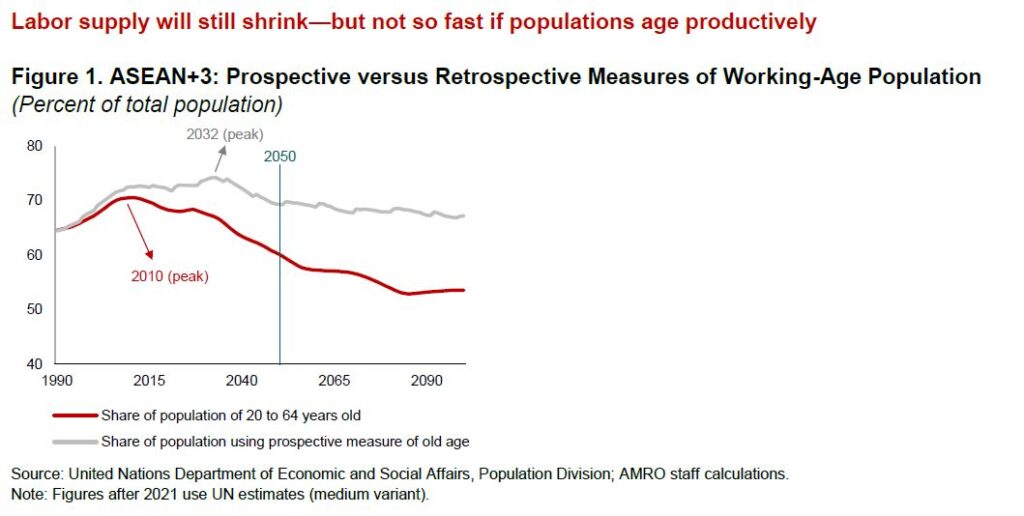While the ASEAN+3 region will remain a major driver of global growth in the next decade, it also faces a multitude of structural challenges. Three secular trends—aging, global trade reconfiguration, and rapid technological change—are affecting the region in complex ways that make its long-term growth trajectory less certain. But these trends also create opportunities for innovation, productivity gains, as well as new and inclusive sources of future growth. Successfully navigating these cross-currents requires a careful balancing act of the ASEAN+3 economies to prioritize policies in regard to infrastructure, innovation, inclusivity, and international cooperation.
ASEAN+3 has come a long way in the past two decades: now the largest economic region in the world, it has enjoyed solid and more stable growth—even when compared to its richer peers.
With years of solid macroeconomic fundamentals, improvements in governance, and enhanced external resilience, all the regional economies have transitioned to middle-income status, with half of our region well-positioned to become high-income economies by the end of this decade.
But getting there may not be smooth sailing. Concerns are rising that the various tailwinds behind such remarkable growth are dissipating: the global economy is projected to grow more slowly than it did in the past decade. Productivity growth, which has allowed the region to move up the income ladder, has slowed, and the COVID-19 pandemic has left big scars on some economies which will remain a drag on growth.
Navigating the future environment becomes even more daunting when considering key secular trends confronting ASEAN+3. Aging, global trade reconfiguration, and rapid technological changes are making the growth path of ASEAN+3 more opaque. How could these economies navigate tomorrow?
Aging: Age is not just a number
Fertility rates are declining faster in ASEAN+3 than in many parts of the world and are well below the 2.1 replacement rate in many economies. The strong growth in the region’s working-age population—the source of the “demographic dividend” that has helped spur economic growth in the past—is rapidly dissipating and projected to turn negative before this decade ends.
This trend carries potentially negative implications for ASEAN+3’s long-term growth, economic stability, and health of public finances. For some economies, rapid aging is occurring at relatively lower levels of per-capita income—fueling apprehensions about falling into the “middle-income trap”.
But when one considers how the population is living longer and aging more slowly and in a healthier manner, the ASEAN+3 region, in fact, has a new and largely untapped resource: an expanding older population who can be productive for longer.
About 200 million workers above the age of 60 can re-enter the region’s labor force by 2050—but only if our populations are allowed to age productively (Figure 1). Leveraging this latent resource requires society to view aging as not just something to cope with, but something to reap benefits from.
By rethinking aging—from how many years one has lived to how many more years one has left—ASEAN+3 can successfully turn the “demographic dividend” of the past into the “longevity dividend” of the future.

Trade reconfiguration: Not all doom and gloom
The ongoing reconfiguration in global trade also carries major implications for ASEAN+3’s time-tested export strategies.
The value of global goods trade continues to remain below its historical peak. Geopolitical dynamics are increasingly realigning trade relations and, along with increasing concentration of trade, could translate into lower economic security for ASEAN+3. Furthermore, the estimated costs of geoeconomic fragmentation could be staggering for the world economy.
Yet, most ASEAN+3 economies are well equipped to rise above the currents of geoeconomic fragmentation and to turn the tide into growth opportunities, thanks to their commitment to openness and neutrality. Some have been able to position themselves as alternative supply “nodes” between China and the US, leveraging their manufacturing capabilities (Figure 2).
Amid the gloom of fragmentation, ASEAN economies have the opportunity to reindustrialize, refine their long-term FDI and industrial policies, and discover new growth drivers.
Despite the slowdown in global goods trade, the momentum behind cross-border services trade—especially those powered by digital technology—should unlock new avenues for sustainable and inclusive growth.

Rapid tech: Will your new colleague be a robot?
Technology has long buoyed growth and productivity in ASEAN+3. It will continue to do so, helping unlock solutions to the challenges of aging, trade reconfiguration, and other pressing structural issues.
Yet, many new technological breakthroughs—such as digitalization and artificial intelligence (AI)—are fundamentally changing business models and the ways that regional economies utilize their factors of production. The rise of generative AI—the technology behind ChatGPT—is especially garnering policymakers’ attention, given its potential to displace jobs globally.
Our initial analysis suggests that more jobs in the ASEAN+3 region are likely to be augmented rather than automated by Gen AI (Figure 3). The impact varies with skills and gender. Medium-skilled jobs face a higher risk of automation, while high-skilled jobs could benefit more from augmentation. Based on the types of tasks that can be affected by Gen AI, women’s jobs are likely to be affected more than men’s.
Given these uneven effects on employment, the ASEAN+3 region should be prepared to make the most out of AI’s growth-enhancing capabilities while minimizing the risk of exacerbating inequalities.

Not all policies are created equal
All ASEAN+3 economies are exposed to these secular shifts, although to varying degrees. Notwithstanding each economy’s policy priority, the challenge is to navigate the current environment with “robust” policies that perform well under various possible futures and can reinforce each other.
For ASEAN+3, we have identified four broad pillars to inform such policymaking: (1) expand quality infrastructure; (2) encourage innovation and knowledge diffusion; (3) promote inclusivity; and (4) champion multilateral cooperation.
Despite all the uncertainties, navigating tomorrow with these pillars will become a less daunting task. Well-designed domestic policies, along with stronger regional cooperation, will be key toward a robust, sustainable, and high-quality future for the ASEAN+3 region.
